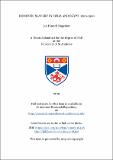Files in this item
Domestic slavery in Syria and Egypt, 1200-1500
Item metadata
| dc.contributor.advisor | Peacock, A. C. S. (Andrew C. S.) | |
| dc.contributor.advisor | Stewart, Angus Donal | |
| dc.contributor.advisor | Greenwood, Tim | |
| dc.contributor.author | Hagedorn, Jan Hinrich | |
| dc.coverage.spatial | 236 p. | en_US |
| dc.date.accessioned | 2019-09-09T13:45:35Z | |
| dc.date.available | 2019-09-09T13:45:35Z | |
| dc.date.issued | 2019-12-04 | |
| dc.identifier.uri | https://hdl.handle.net/10023/18438 | |
| dc.description.abstract | This study investigates domestic slavery in Syrian and Egyptian society from the thirteenth century to the fifteenth century. It focuses on the agency of slaves in the context of master-slave relationships within households and in wider society. It argues that the ability of slaves to shape the world around them was underpinned by a constant process of negotiation within the master-slave relationship and that intermediaries such as the court system channelled the agency of slaves. The principal sources for this study are purchase contracts, listening certificates, marriage contracts, and estate inventories in combination with scribal, market inspection, and slave purchase manuals as well as chronicles. The structure of the study broadly follows the life cycle of slaves from importation to integration, accommodation, procreation, the possibility of manumission, and death. The first chapter investigates the topography and the commercial practices of slave markets, where owners chose slaves and initiated a deeply unequal personal bond which assigned a new function and identity to newly imported slaves. The second chapter provides two case studies based on manuscript collections in order to historicize and problematize the patterns set out previously. The third chapter studies the social integration of slaves and freed slaves on the basis of listening certificates. It argues that the slave population consisted mainly of imported Ethiopian and Turkish slaves who were highly integrated into urban society. The fourth chapter discusses the sexual dimension of domestic slavery by focusing on concubinage, marriage, and slave procreation. It brings together a range of documentary and legal sources to provide case studies of strategies of accommodation and resistance. The fifth chapter investigates manumission and its impact on the household dynamics of slavery. The sixth and final chapter analyses a collection of estate inventories of freed slaves and discusses the continuity of master-slave relations after manumission. | en_US |
| dc.language.iso | en | en_US |
| dc.publisher | University of St Andrews | |
| dc.subject | History | en_US |
| dc.subject | Islamic studies | en_US |
| dc.subject | Social history | en_US |
| dc.subject | Middle Ages | en_US |
| dc.subject | Middle East | en_US |
| dc.subject | Mediaeval history | en_US |
| dc.subject | Middle Eastern studies | en_US |
| dc.subject | Syria | en_US |
| dc.subject | Egypt | en_US |
| dc.subject | Mamluk | en_US |
| dc.subject | Mamluk studies | en_US |
| dc.subject | Mamluk Empire | en_US |
| dc.subject | Mamluk social history | en_US |
| dc.subject | Slavery | en_US |
| dc.subject | Slaves | en_US |
| dc.subject | Agency | en_US |
| dc.subject | Household | en_US |
| dc.subject | Manuscripts | en_US |
| dc.subject | Slave trade | en_US |
| dc.subject.lcc | HT1316.H2 | |
| dc.subject.lcsh | Slavery--Middle East--History | en |
| dc.subject.lcsh | Slavery--Syria--History--To 1500 | en |
| dc.subject.lcsh | Slavery--Egypt--History--To 1500 | en |
| dc.subject.lcsh | Slaves--Middle East--Social conditions | en |
| dc.subject.lcsh | Mamelukes | en |
| dc.title | Domestic slavery in Syria and Egypt, 1200-1500 | en_US |
| dc.type | Thesis | en_US |
| dc.contributor.sponsor | Arts and Humanities Research Council (AHRC) | en_US |
| dc.contributor.sponsor | Scottish Graduate School for Arts and Humanities (SGSAH) | en_US |
| dc.contributor.sponsor | University of St Andrews. School of History | en_US |
| dc.type.qualificationlevel | Doctoral | en_US |
| dc.type.qualificationname | PhD Doctor of Philosophy | en_US |
| dc.publisher.institution | The University of St Andrews | en_US |
| dc.publisher.department | School of History | en_US |
| dc.identifier.doi | https://doi.org/10.17630/10023-18438 |
This item appears in the following Collection(s)
Items in the St Andrews Research Repository are protected by copyright, with all rights reserved, unless otherwise indicated.

